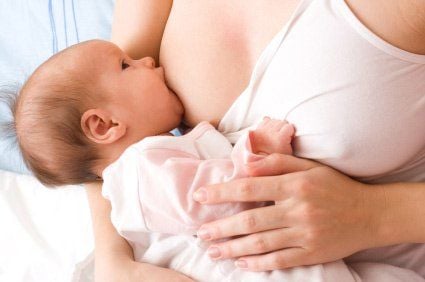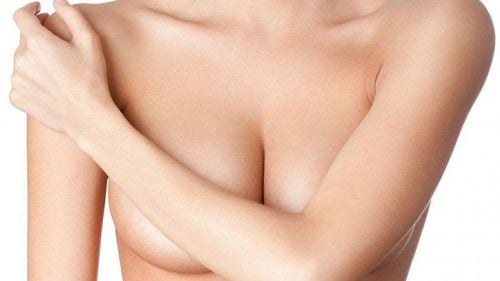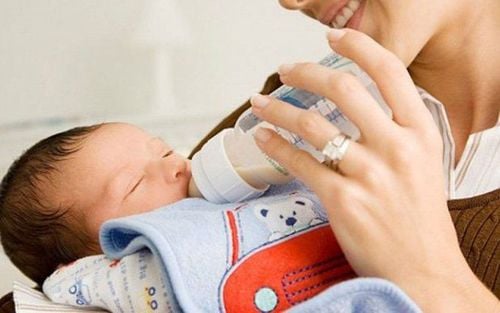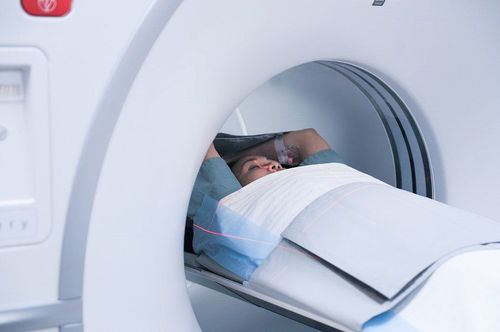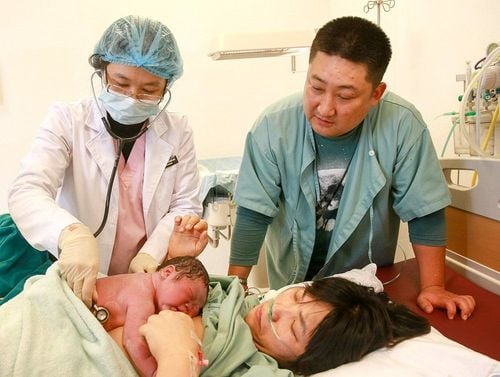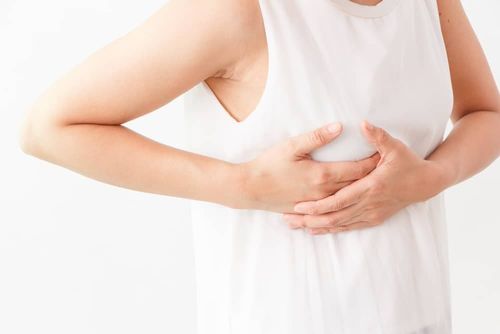This is an automatically translated article.
Breast infection is an inflammation of the mammary gland tissue, usually occurs acutely and is caused by bacteria. If a breast infection is not detected and treated promptly, it can lead to more serious complications, including a breast abscess with pus discharge from the breast.1. Structure of the mammary gland
The mammary gland is made up of glandular tissue and ducts that extend all the way to the tip of the nipple. The ducts are responsible for carrying milk secreted from the glandular tissues to the subcutaneous tissue at the nipple and areola. These ducts are very active and contain a lot of milk during lactation. When a girl enters puberty, the change in the level of sex hormones in the body stimulates the ducts to proliferate and deposit a lot of fatty tissue inside, causing the mammary glands to increase in size. The lactational tissue is connected to the surface of the mammary gland by ducts and may extend to the axillary region.2. Causes of breast infection
A breast infection is an inflammation and pus formation of the cellular tissues in the mammary gland, which usually occurs during lactation, which can lead to a breast abscess. The most common causative agent of breast infection is bacteria, usually originating in the infant's oral cavity, that enter the mammary ducts through lesions in the nipple.Breast infections are very common around 1 to 3 months postpartum, but they can also occur in women with no recent history of childbirth and in women who have gone through menopause. Other causes of breast infection include chronic mastitis and inflammatory breast carcinoma.
In healthy women, mastitis rarely occurs. In contrast, people with diabetes, AIDS, or other chronic medical conditions that cause immunosuppression have a higher risk of developing breast infections.
Breast infections occur in about 1% to 3% of breastfeeding women. Local hematoma and incomplete emptying of the breast may be risk factors for worsening of the disease.
Chronic mastitis occurs in non-breastfeeding women. In postmenopausal women, breast infections are associated with chronic inflammation of the ducts below the nipple. Hormonal changes in the body can block the lumen of the milk ducts with necrotic tissue. This phenomenon increases the risk of ductal infection. Infections tend to recur many times after treatment with drugs alone.
3. Signs of breast infection

Đau và phù nề tuyến vú là dấu hiệu điển hình để nhận biết nhiễm trùng vú
Pain and swelling of the mammary gland Fever and chills General fatigue, body aches Congestion in the mammary gland Occurrence of abscesses: Pressure Cartilage can be one of the complications of mastitis. Breast abscesses are benign, tender, tender, and mobile subsurface masses. The margins of the abscess are well-defined and even. Severe mammary gland infection often manifests with the following signs:
Swollen mass in the mammary gland that does not shrink in size after breastfeeding. However, if the abscess is located posteriorly under the mammary gland, the patient may not notice it. Nipple discharge from nipple. Symptoms of fever are persistent and do not improve after 48 to 72 hours of treatment. Patients should seek medical attention immediately if they detect suspicious symptoms whether they are breastfeeding or not. In the case of breast pain that is accompanied by signs of an infection such as fever, swelling, and redness of the skin of the mammary gland, the patient should be taken to the emergency room for prompt diagnosis and treatment. Some of the symptoms that are signs that require urgent treatment include:
A persistently high fever above 39 degrees Celsius Vomiting or nausea that prevents the person from taking medicine. Breast discharge Swollen and red areas of skin that spread to the hands and chest Dizziness, fatigue, or confusion.
4. Diagnosis of breast infection
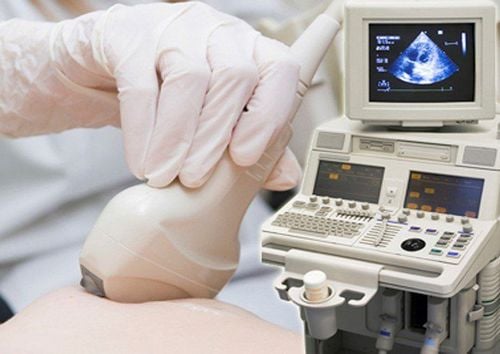
Siêu âm là phương tiện giúp ích trong việc phân biệt viêm tuyến vú đơn thuần và áp xe vú hoặc phát hiện các khối áp xe nằm sâu bên dưới mô tuyến vú
Culture of breast milk or drainage of inflammatory fluid from an abscess can be performed to identify the causative agent, thereby determining the specific antibiotic to use for each patient.
Mastitis occurs in non-breastfeeding women or mastitis cases that respond poorly to treatment should be investigated in more detail with mammography or biopsy of the breast tissue. Inflammatory carcinoma of the breast, a rare type of breast cancer that can cause symptoms similar to those of a breast infection.
5. Treatments for Breast Infections
5.1 Treatment of breast infection at home Besides the examination and adherence to treatment by the doctor, the patient can apply the following measures to promote the recovery of inflammatory breast tissue, including:Medicines pain relief: acetaminophen or ibuprofen are common, over-the-counter pain relievers that can be used at home. These drugs have been shown to be safe for infants during breastfeeding. If breast pain does not improve with these medications, your doctor will prescribe more specific pain relievers. In mild cases of mastitis, antibiotics may not be needed. However, if the doctor prescribes antibiotics, the patient needs to complete the full course of treatment even though the symptoms have improved in the following days. Breastfeeding often: Do not stop breastfeeding when a breast infection occurs, even breastfeeding causes more pain or is taking antibiotics. Emptying the mammary gland prevents ductal obstruction and improves the inflammatory process. If necessary, use a breast pump to relieve pressure and aid in the dilation process. Breastfeeding should be delayed if a breast abscess occurs. Applying a warm compress to the breast before and after feeding can help relieve pain. If hot compress is not effective, it can be replaced by using an ice pack after breastfeeding. Do not apply cold before feeding because it causes the milk ducts to shrink, reducing milk production. Drink plenty of water, at least 10 glasses of water a day. Maintain a balanced diet, adding an extra 500 calories per day throughout breastfeeding. Lack of water and poor diet reduce milk supply, making the mother's body become more tired. 5.2 Medicines to treat breast infections

Đối với những trường hợp viêm vú đơn thuần không kèm các khối áp xe, kháng sinh đường uống là thuốc đầu tay được sử dụng
Chronic mastitis in non-breastfeeding women is a more complicated case. The disease often recurs many times. Often, breast infections in this setting respond poorly to antibiotic use, so the patient should be closely monitored by the treating physician.
If the infection becomes more severe or does not respond to oral antibiotics, the patient should be prescribed intravenous drugs.
5.3 Surgical removal of breast abscess Patients with breast infection complicated by breast abscess require interventional therapy in combination with antibiotics. Abscess drainage with local anesthetic for tumors close to the skin surface of the mammary gland is the most common procedure. Fluid in the abscess is aspirated and drained with a fine needle.
Conversely, if the abscess is deep in the breast tissue, surgical drainage in the operating room is the preferred option. This procedure is usually done while the patient is under anesthesia to relieve pain.
Uncomplicated breast infection leads to malignancy, but breast cancer may present with clinical manifestations similar to breast infections. If a patient presents with persistent symptoms of a breast infection, the treating physician may recommend additional diagnostic means to rule out cancer.
Vinmec International General Hospital with a system of modern facilities, medical equipment and a team of experts and doctors with many years of experience in medical examination and treatment, patients can rest assured to visit. examination and treatment at the Hospital.
To register for examination and treatment at Vinmec International General Hospital, you can contact Vinmec Health System nationwide, or register online HERE.
Reference source: webmd.com
SEE MORE
Easy mastitis due to blocked milk glands Recognizing and treating fibrocystic mastitis Benign diseases can occur in the mammary glands




